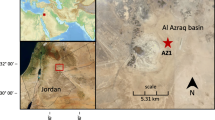Abstract
The oxygen isotopes of albite, quartz, and zeolites from the Hokonui Hills, New Zealand, constrain crystallization temperatures and the type of pore fluids present during diagenesis. A section of altered vitric tuffs in this region contains an extremely sharp reaction boundary between a heulandite-chlorite assemblage containing fresh detrital plagioclase and a laumontite-albite-quartz assemblage. A laumontite vein follows the local joint pattern and forms the reaction boundary, suggesting that laumontitization occurred as a result of fracturing and increased fluid flow during uplift. The albite (δ18O = + 15.0)-quartz (δ18O = + 19.9 to + 20.5) geothermometer constrains the temperature of alteration between 145° and 170°C with a pore water δ18O of + 1.8 to + 3.5. The tuff was buried to an estimated maximum temperature of about 225°C, indicating that alteration occurred after maximum burial.
Framework oxygen was extracted from zeolites by reaction with ClF3 after the zeolites were thermally dehydrated in a vacuum. Laumontite was dehydrated at 300°C, and stilbite at 150°C. The precision of the method is typically about ±0.45‰. Fractionation curves for dehydrated zeolites are based on a general expression from the literature for feldspars, which depends only on the Si/Al ratio of the mineral. Measured δ18O values for laumontite in the groundmass of the altered tuff were + 14.4‰. The laumontite-quartz pair constrains the temperature to between 139° and 162°C, in excellent agreement with the albite-quartz pair, and supporting the petrographic observation of co-crystallizing albite-laumontite.
Oxygen isotope values for fracture-filling laumontite in the vitric tuff, as well as those for groundmass and vein laumontite from other parts of the stratigraphic section, cluster around + 14.5, suggesting that laumontite probably crystallized under similar conditions throughout much of the section. Oxygen isotope values for stilbite veins from various parts of the section indicate that this mineral crystallized at lower temperatures than the laumontite, for a given fluid isotopic composition, in agreement with the observed cross-cutting of laumontite by stilbite.
Similar content being viewed by others
References
Boles, J. R. (1971) Stratigraphy, petrology, mineralogy, and metamorphism of mainly Triassic rocks, Hokonui Hills, Southland, New Zealand: Ph.D. thesis, University of Otago, Dunedin, New Zealand, 406 pp.
Boles, J. R. (1974) Structure, stratigraphy, and petrology of mainly Triassic rocks, Hokonui Hills, Southland, New Zealand: New Zealand Geol. Geophys. 17-2, 337–374.
Boles, J. R. (1982) Active albitization of plagioclase, Gulf Coast Tertiary: Amer. J. Sci. 282, 165–180.
Boles, J. R. and Coombs, D. S. (1975) Mineral reactions in zeolitic Triassic tuff, Hokonui Hills, New Zealand: Geol. Soc. Amer. Bull. 86, 163–173.
Boles, J. R. and Coombs, D. S. (1977) Zeolite facies alteration of sandstone in the Southland syncline, New Zealand: Amer. J. Sci. 11, 982–1012.
Breck, D. W. (1974) Zeolite Molecular Sieves: Structure, Chemistry and Use: Wiley, New York, 771 pp.
Clayton, R. N., O’Neil, J. R., and Mayeda, T. K. (1972) Oxygen isotope exchange between quartz and water: J. Geophys. Res. 11, 3057–3067.
Clayton, R. N., Friedman, I., Graf, D. L., Mayeda, T. K., Meents, W. F., and Shimp, N. F. (1966) The origin of saline formation waters. I. Isotopic composition: J. Geophys. Res. 71, 3869–3882.
Clayton, R. N. and Mayeda, T. K. (1963) The use of bromine pentafluoride in the extraction of oxygen from oxides and silicates for isotopic analysis: Geochim. Cosmochim. Acta 27, 43–52.
Coombs, D. S. (1954) The nature and alteration of some Triassic sediments from Southland, New Zealand: Trans. Roy. Soc. N.Z. 82, 65–109.
Coombs, D. S., Ellis, A. J., Fyfe, W. S., and Taylor, A. M. (1959) The zeolite facies, with comments on the interpretation of hydrothermal syntheses: Geochim. Cosmochim. Acta 17, 53–107.
Friedman, I. and O’Neil, J. R. (1977) Compilation of stable isotope fractionation factors of geochemical interest: U.S. Geol. Survey Prof. Pap. 440-KK, 49 pp.
Fyfe, W. S., Turner, F. J., and Verhoogen, J. (1958) Metamorphic reactions and metamorphic facies: Geol. Soc. Amer. Mem. 73, 259 pp.
Gensse, C, Anderson, T. F., and Friplat, J. J. (1980) Study of oxygen mobility in some synthetic faujasites by isotopic exchange with CO2: J. Phys. Chem. 84, 3562–3567.
Gottardi, G. and Galli, E. (1985) Natural Zeolites: Springer-Verlag, Berlin, 409 pp.
Kastner, M. and Siever, R. (1979) Low temperature feldspars in sedimentary rocks: Amer. J. Sci. 279, 435–479.
Land, L. S. and Milliken, K. L. (1981) Feldspar diagenesis in the Frio Formation, Brazoria County, Texas Gulf Coast: Geology 9, 314–318.
O’Neil, J. R. and Taylor, H. P., Jr. (1967) The oxygen isotope and cation exchange chemistry of feldspars: Amer. Mineral. 52, 1414–1437.
Savin, S. M. (1980) Oxygen and hydrogen isotope effects in low temperature mineral-water interactions: in Handbook of Environmental Isotope Geochemistry–Vol. 1, P. Fritz and J. Ch. Fontes, eds., Elsevier, New York, 283–328.
Stallard, M. L. (1986) Albitization and zeolitization in Triassic/Jurassic volcanogenic rocks, Hokonui Hills, New Zealand: M.A. thesis, Univ. Calif., Santa Barbara, California, 151 pp.
Trevena, A. S. and Nash, N. P. (1981) An electron microprobe study of detrital feldspar: J. Sed. Petrol. 51, 137–150.
von Ballmoos, R. and Meier, W. M. (1982) Oxygen-18 exchange between zeolite ZSM-5 and water: J. Phys. Chem. 86, 2698–2700.
Yeh, H. W. and Savin, S. M. (1977) The mechanism of burial metamorphism of argillaceous sediments, 3. Oxygen isotopic evidence: Geol. Soc. Amer. Bull. 88, 1321–1330.
Author information
Authors and Affiliations
Additional information
Presented at Symposium on the Geology, Genesis, Synthesis, and Use of Zeolites at 38th annual meeting of the Clay Minerals Society, Jackson, Mississippi, October 1986, convened by R. J. Donahoe. Manuscript reviewing and editing coordinated by R. J. Donahoe and R. A. Sheppard.
Rights and permissions
About this article
Cite this article
Stallard, M.L., Boles, J.R. Oxygen Isotope Measurements of Albite-Quartz-Zeolite Mineral Assemblages, Hokonui Hills, Southland, New Zealand. Clays Clay Miner. 37, 409–418 (1989). https://doi.org/10.1346/CCMN.1989.0370504
Received:
Accepted:
Published:
Issue Date:
DOI: https://doi.org/10.1346/CCMN.1989.0370504



